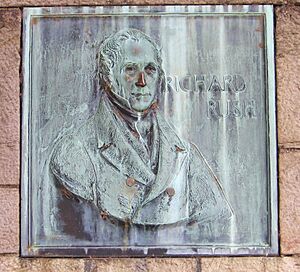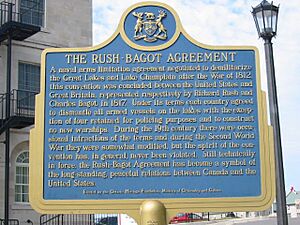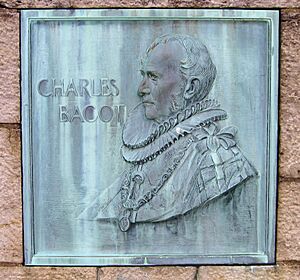Rush–Bagot Treaty facts for kids
| Exchange of Notes Relative to Naval Forces on the American Lakes | |
|---|---|

Historical marker where the Rush–Bagot Agreement was made in Washington, D.C.
|
|
| Type | Arms control |
| Context | Aftermath of the War of 1812 |
| Signed | April 28 and 29, 1817 |
| Location | 2425 L Street NW, Washington, D.C. |
| Effective | April 28, 1818 |
| Negotiators | |
| Signatories | |
| Parties |
|
| Language | English |
The Rush–Bagot Treaty was an important agreement between the United States and Great Britain. It helped to limit the number of warships and weapons on the Great Lakes and Lake Champlain. This happened after the War of 1812, a conflict between the two nations.
The treaty was officially approved by the United States Senate on April 16, 1818. Later, in 1867, Canada also confirmed it after it became a country. This agreement led to a large reduction of military ships and forts on the lakes along the border.
The treaty said that the United States and British North America (which is now Canada) could each have only one military ship on Lake Ontario and Lake Champlain. These ships could not be heavier than 100 tons and could only have one cannon, no bigger than an 18-pounder. On the other Great Lakes, each side could have two similar ships with similar weapons. This treaty, along with another one called the Treaty of 1818, helped create a peaceful border between the U.S. and British North America.
Contents
How the Rush-Bagot Treaty Began

The idea for the Rush–Bagot Treaty came from letters exchanged in April 1817. These letters were between Richard Rush, who was the acting Secretary of State for the United States, and Sir Charles Bagot, who was the British Minister in Washington.
Once they agreed on the terms in these letters, both countries started following the Rush–Bagot Agreement unofficially. On April 6, 1818, the agreement was sent to the United States Senate. It was officially approved on April 16, 1818.
This treaty later helped lead to the Treaty of Washington in 1871, which further reduced military presence. In 1946, the United States and Canada agreed that naval ships could be on the lakes for training. However, each government had to tell the other beforehand.
Modern Challenges to the Treaty
In 2004, the United States Coast Guard decided to put machine guns on 11 of its small patrol boats. These boats were stationed on Lake Erie and Lake Huron. This decision was made because there were more smuggling activities and a greater threat of terrorism after the attacks on September 11, 2001.
The Canadian government looked at this and decided it did not break the treaty. They saw the guns as being used for law enforcement, like stopping crime, not for military fighting. Canada also said it could arm its own law enforcement boats with similar weapons if needed.
Military Presence Near the Great Lakes
Even though the Rush–Bagot Treaty limited military ships, there are still some military places near the Great Lakes. These are mostly training centers or bases for support, not for large-scale naval warfare.
For example, HMCS Stone Frigate at the Royal Military College of Canada in Kingston, Ontario, was built in the 1820s. It was used to store parts of the British fleet that were taken apart because of the Rush–Bagot Treaty.
Here are some of the military facilities in the area:
- Canada
- CFB Borden, Borden, Ontario: A training center for the Canadian Forces.
- CFB Kingston, Kingston, Ontario: A training center and home to naval reserve units.
- CFB Trenton, Trenton, Ontario: Canada's largest airbase, used for transport and rescue.
- Royal Military College, Kingston, Ontario: A college for military cadets and staff.
- United States
- Naval Station Great Lakes - North Chicago, Illinois: A training facility for new recruits of the United States Navy.
- Niagara Falls Air Reserve Station, Niagara Falls, New York: An air force base.
- Selfridge Air National Guard Base, Harrison Township, Michigan: A training facility for various military branches.
The Treaty's Lasting Impact
The Rush–Bagot Agreement helped make the Canada–United States border a peaceful one. This includes the Great Lakes and Lake Champlain. The U.S. and Britain also agreed to share control over the Oregon Territory.
This treaty helped create the world's longest border between two countries that is not guarded by many soldiers or weapons. It stretches for about 8,891 kilometers (5,525 miles).
The treaty faced challenges during World War I and World War II. However, its terms were not changed much. Leaders wanted to keep the agreement because it was so important for peace. During World War II, Canada and the United States agreed that weapons could be put on ships in the Great Lakes. But they could only be used once the ships left the lakes. Later, they agreed that weapons could be fully installed and tested during the war.
After the war, in 1946, Canada suggested that ships could be used for training. This was allowed as long as each country told the other beforehand.
Markers and Memorials

There are several places where you can find plaques and memorials about the Rush–Bagot Agreement.
An Ontario Heritage Trust plaque in Kingston, Ontario, recognizes the agreement. There is also a plaque at the place where the agreement was negotiated in Washington, D.C..
A monument stands at Old Fort Niagara. This monument has images of both Richard Rush and Charles Bagot. It also includes the words of the treaty itself.
Images for kids
-
HMCS Stone Frigate, Royal Military College of Canada, Kingston, Ontario




